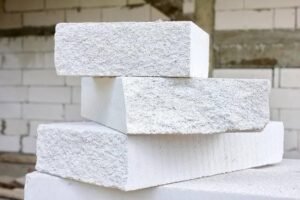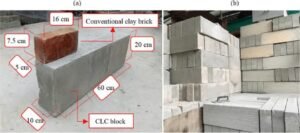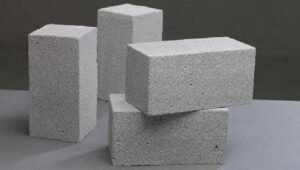Lightweight concrete blocks are construction materials made with lightweight aggregates like expanded clay, pumice, or other similar materials. They are ideal for projects requiring reduced structural load, thermal insulation, or soundproofing.
Lightweight concrete blocks are revolutionizing the construction industry by offering a durable, versatile, and efficient alternative to traditional building materials. These blocks, made from lightweight aggregates such as expanded clay, pumice, or perlite, are a modern answer to the demand for sustainable and cost-effective construction. Whether you’re building a residential property, a commercial structure, or any other type of building, lightweight concrete blocks provide numerous advantages that can enhance the overall quality and efficiency of your project.
What Are Lightweight Concrete Blocks?
Lightweight concrete blocks are a type of masonry unit designed to reduce the overall weight of a structure without compromising strength or durability. They are made by replacing traditional dense aggregates with lightweight alternatives. The result is a block that weighs significantly less than standard concrete blocks, making them easier to handle and install. These blocks come in various shapes and sizes to suit different construction needs and are often used in walls, partitions, and insulation.
Benefits of Lightweight Concrete Blocks
1. Reduced Structural Load
One of the primary benefits of lightweight concrete blocks is their ability to reduce the overall weight of a structure. This characteristic is particularly advantageous for high-rise buildings, where reducing the dead load can lead to significant savings in foundation and structural support costs.
2. Improved Workability
The lighter weight of these blocks makes them easier to transport, handle, and install. Construction workers can move them with less effort, which speeds up the building process and reduces labor costs. Additionally, their lighter weight minimizes the risk of workplace injuries associated with heavy lifting.
3. Enhanced Thermal Insulation
Lightweight concrete blocks have excellent thermal insulation properties due to their porous structure. This quality helps maintain indoor temperatures, reducing the need for artificial heating or cooling. Consequently, buildings constructed with these blocks are more energy-efficient, leading to lower utility bills and a reduced carbon footprint.
4. Soundproofing Capabilities
The porous nature of lightweight concrete also provides effective sound insulation. Buildings made with these blocks are quieter, making them ideal for residential and commercial spaces where noise reduction is essential.
5. Durability and Longevity
Despite their reduced weight, lightweight concrete blocks are highly durable. They are resistant to cracking, fire, and weathering, ensuring a longer lifespan compared to some traditional materials. This durability translates into lower maintenance costs over time.
6. Eco-Friendliness
Lightweight concrete blocks are an environmentally friendly option for construction. The production process often involves recycled materials, and their thermal insulation properties contribute to energy conservation. Using these blocks aligns with sustainable building practices and helps reduce the environmental impact of construction projects.
7. Versatility in Applications
These blocks can be used in various types of construction, from residential homes to commercial buildings, schools, hospitals, and more. They are also suitable for interior and exterior walls, partitions, and load-bearing structures.
Types of Lightweight Concrete Blocks
There are several types of lightweight concrete blocks, each with unique properties and applications:
1. Autoclaved Aerated Concrete (AAC) Blocks
AAC blocks are made from a mixture of cement, lime, water, and an aerating agent. They are cured in an autoclave, which enhances their strength and durability. AAC blocks are highly popular due to their excellent thermal and acoustic insulation properties.
2. Foam Concrete Blocks
Foam concrete blocks are made by adding foam to a cement-based mixture. They are lightweight, easy to shape, and provide good insulation. These blocks are often used for non-load-bearing walls and partitions.
3. Lightweight Aggregate Blocks
These blocks are made using lightweight aggregates like expanded clay, shale, or pumice. They offer a balance of strength and reduced weight, making them suitable for load-bearing and non-load-bearing applications.
4. Cinder Blocks
Cinder blocks are made using coal cinders as the aggregate. They are lightweight and commonly used in non-load-bearing walls. However, they may not be as strong as other lightweight concrete blocks.
Applications of Lightweight Concrete Blocks
1. Residential Construction
Lightweight concrete blocks are commonly used in residential buildings for walls, partitions, and foundations. Their thermal and sound insulation properties enhance the comfort and quality of living spaces.
2. Commercial Buildings
In commercial construction, these blocks are used for interior and exterior walls, providing durability and reducing overall project costs. Their lightweight nature makes them ideal for large-scale projects.
3. Industrial Structures
Industrial buildings benefit from lightweight concrete blocks due to their fire resistance and durability. They are often used in warehouses, factories, and storage facilities.
4. Infrastructure Projects
Lightweight concrete blocks are also used in infrastructure projects like bridges, culverts, and retaining walls. Their reduced weight simplifies transportation and installation, saving time and resources.
How to Use Lightweight Concrete Blocks Effectively
To maximize the benefits of lightweight concrete blocks, follow these best practices:
Proper Planning: Assess the specific requirements of your project to select the most suitable type of lightweight concrete block.
Skilled Labor: Ensure that workers are trained in handling and installing lightweight concrete blocks to achieve the best results.
Quality Control: Use high-quality blocks from reputable manufacturers to ensure durability and performance.
Appropriate Mortar: Use the right type of mortar to bond the blocks effectively and maintain structural integrity.
Insulation and Finishing: Consider additional insulation or finishing options to enhance the aesthetic and functional properties of the blocks.
Challenges and Limitations
While lightweight concrete blocks offer numerous advantages, there are some challenges to consider:
Higher Initial Cost: Lightweight concrete blocks can be more expensive upfront compared to traditional blocks. However, the long-term savings in energy and maintenance often offset this cost.
Limited Availability: In some regions, lightweight concrete blocks may not be readily available, leading to higher transportation costs.
Lower Compressive Strength: Depending on the type, some lightweight concrete blocks may have lower compressive strength than traditional concrete blocks, limiting their use in certain load-bearing applications.



Key Features
Lightweight: Easier to handle and transport compared to traditional concrete blocks.
Thermal Insulation: Reduces heat transfer, making buildings energy-efficient.
Soundproofing: Provides excellent acoustic insulation.
Durability: Resistant to fire, moisture, and weathering.
Eco-Friendly: Made from sustainable materials in some cases.
Types of Lightweight Concrete Blocks
1. Autoclaved Aerated Concrete (AAC) Blocks: Made with a mixture of sand, lime, cement, and water. They’re lightweight and have excellent insulation properties.
2. Cinder Blocks: Made with coal cinders, offering moderate strength and low weight.
3. Foam Concrete Blocks: Made by introducing air bubbles into the concrete mix, resulting in a very light and versatile product.
Applications
Partition walls in buildings.
Non-load-bearing walls.
Insulation panels.
Prefabricated structures.
Benefits
Ease of Installation: Can be cut and shaped easily.
Cost-Effective: Reduces labor and material costs due to faster installation.
Structural Efficiency: Reduces the overall load on the foundation.
Sustainability: Helps reduce carbon footprint in construction.